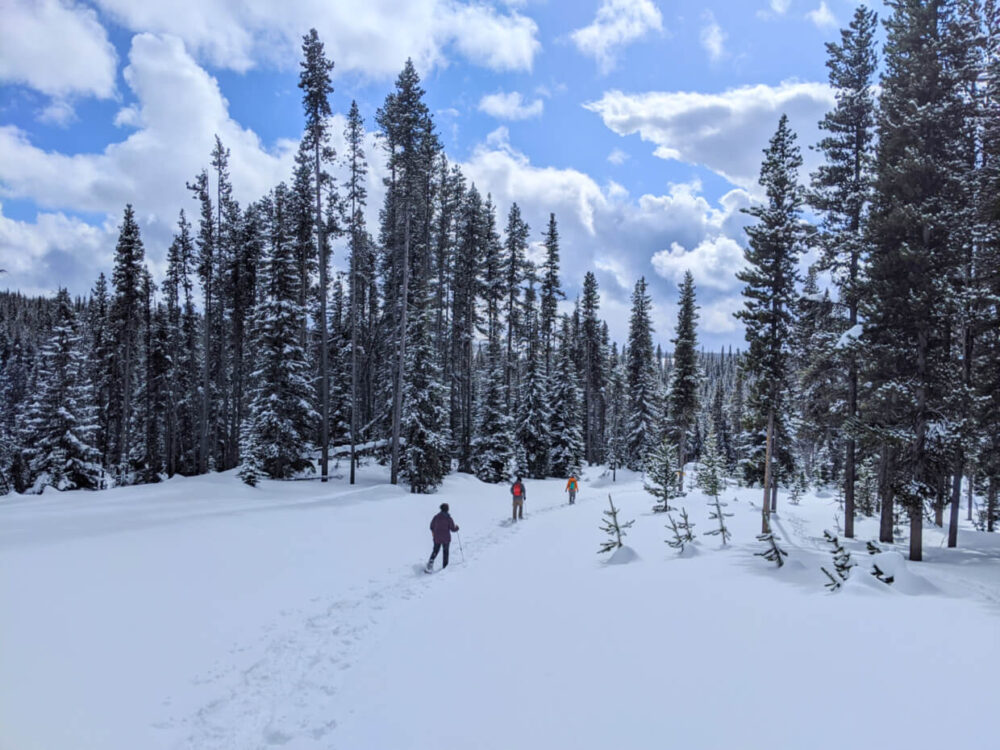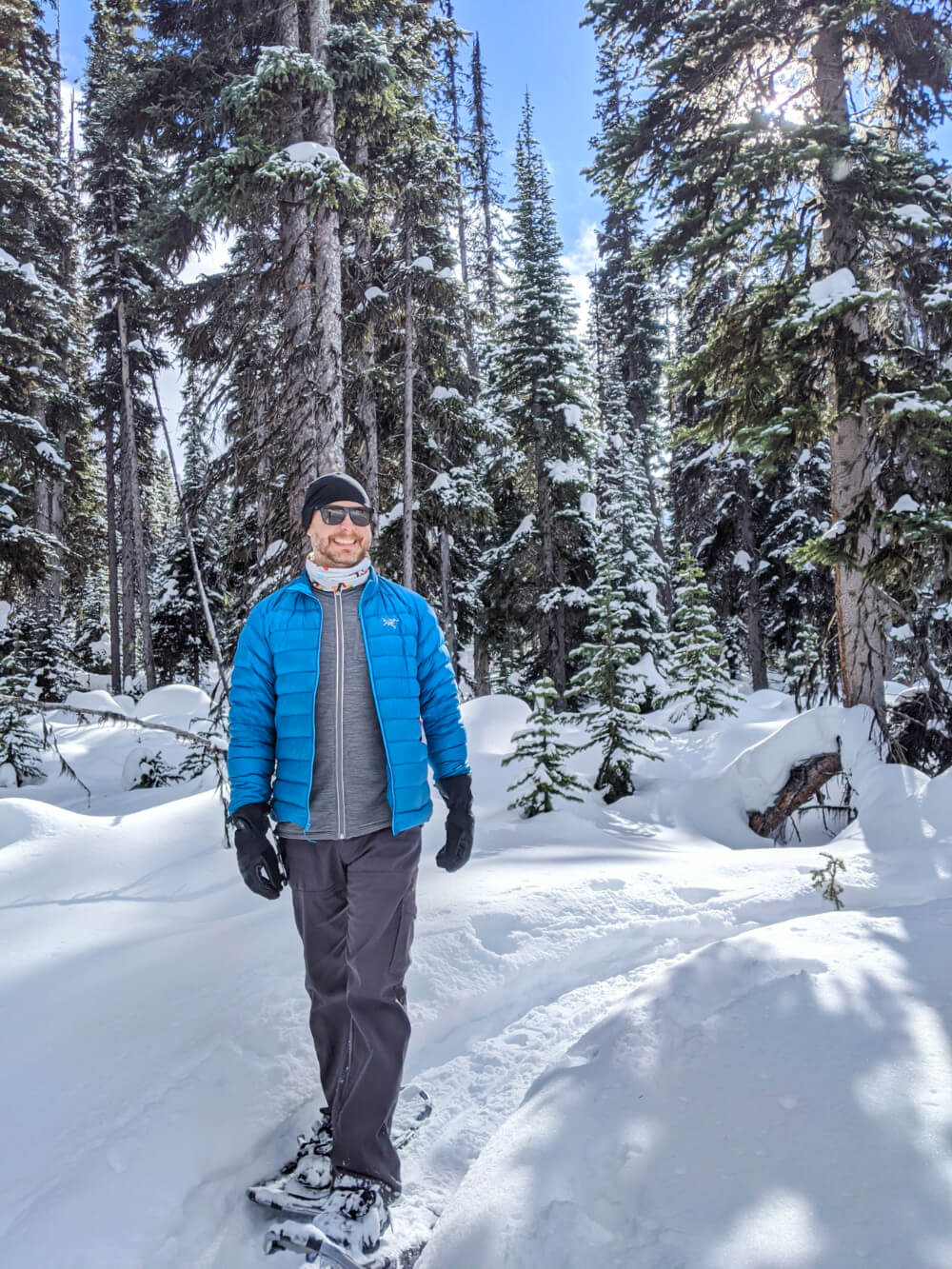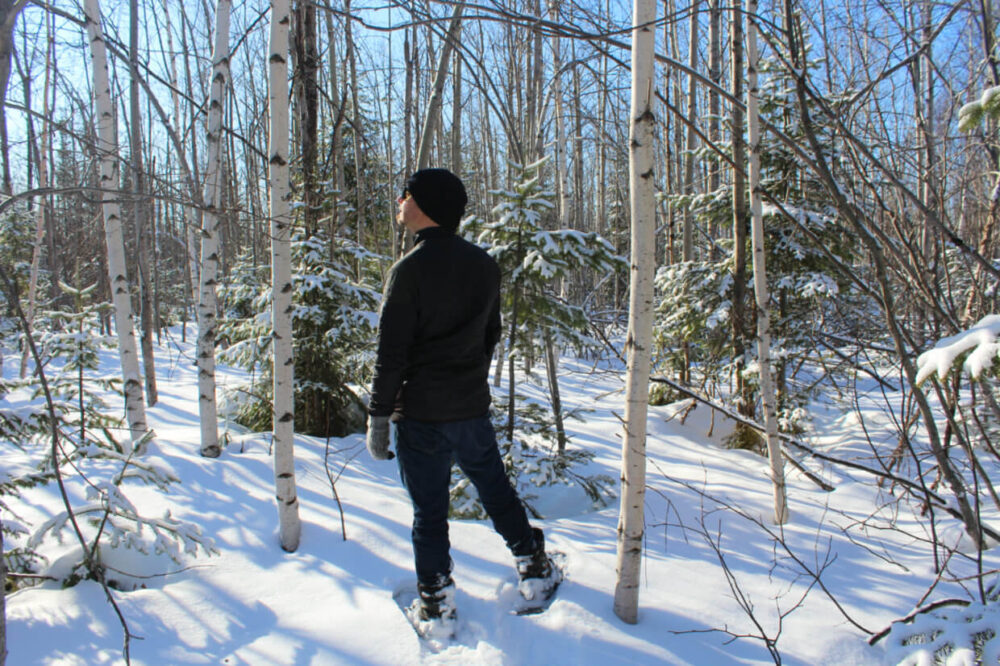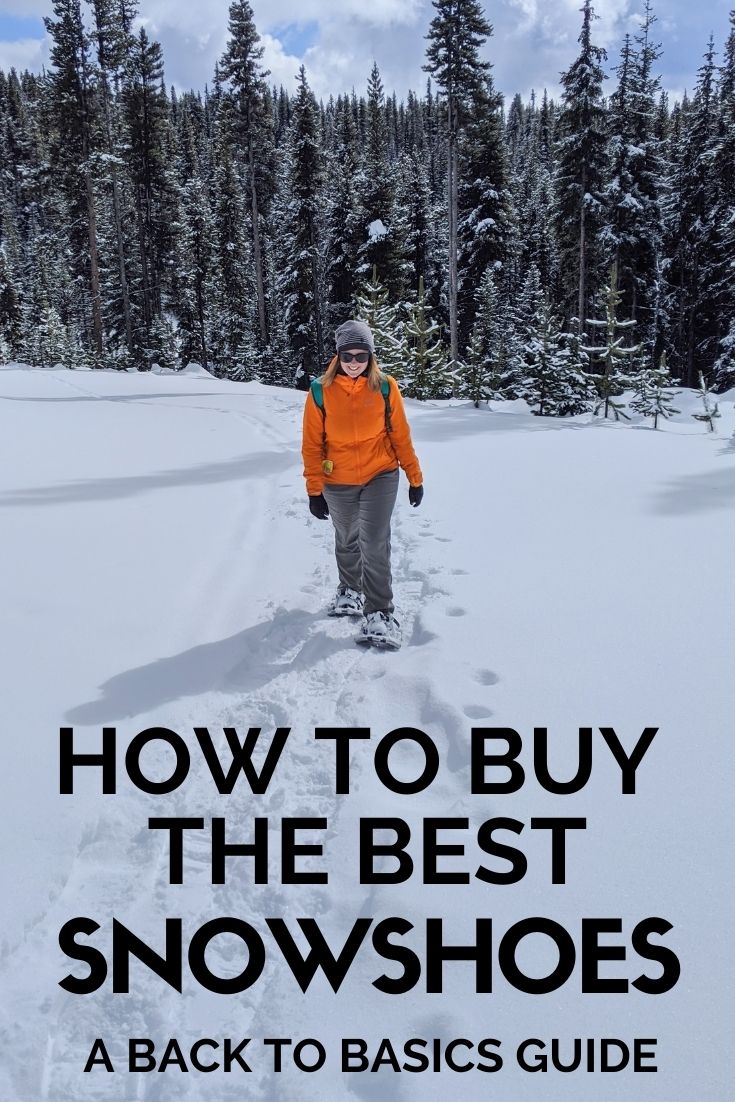As well as being a fun low-impact way to explore winter landscapes, snowshoeing is also incredibly affordable. All you need is a pair of snowshoes and some appropriate winter clothing to get started.
Choosing the best snowshoes isn’t quite a walk in the park, however. Even while writing this post, I became a little overwhelmed by all of the brands and models currently on the market.

As a beginner, it can be especially difficult to work out which are the best snowshoes to buy. This snowshoe buying guide includes:
- A breakdown of the parts of a snowshoe
- An explanation of traction, flotation and different binding types
- How to choose the right size and type of snowshoe
- Where to buy snowshoes
- Specific snowshoe recommendations
- Suggestions of snowshoe accessories
Besides snowshoeing being one of my favourite winter activities, I actually used to sell snowshoes for a living. JR and I once managed an outdoor store together before leaving to travel and blog full time. Our winter months were all about matching customers with the right snowshoes, skis and backcountry safety gear (beacons, probes, shovels) for them.
This post includes affiliate links. If you make a purchase through one of these links, I may receive a percentage of the sale at no extra cost to you.

Snowshoes: the basics
Before I get into specific snowshoe recommendations, I want to take you through the features that define different models and styles. Understanding the jargon can really help when choosing the best snowshoes for you.
Let’s start with a breakdown of the different parts of a snowshoe.
The anatomy of a snowshoe
Modern snowshoe designs are usually oval, around four to five times larger than regular hiking boots.
- The snowshoe frame is usually made of metal, with aluminium and steel being the most common materials. The alternative is composite plastic, which can be lighter but is less durable
- The tail is the back part of the frame, behind the heel of the user. In some snowshoe styles (particularly those for running), the tail narrows to form a sharper point at the end. This allows for a more natural stride but is less stable
- The deck is the main part of the snowshoe, filling the centre of the frame. It creates the surface area that keeps the snowshoe afloat and is usually made of a synthetic material
- The binding keeps your foot attached to the snowshoe. There are many variations and styles but two definitive types – fixed and hinged. I’ll explain a little more about this below
- On the bottom of the snowshoe is a traction system. This can present in a few different forms but typically includes crampons underneath the foot binding and/or side rails (‘teeth’) on the frame
- Some snowshoe models include a heel lifter. This is a metal bar below the heel of a foot that can be lifted to assist with climbing steep hills
How flotation works
The primary purpose of snowshoes is to reduce how much you sink into snow. They do this by spreading your weight over a larger surface area. This is called flotation and is particularly crucial when snowshoeing in the backcountry, away from established trails.
To put it simply – the longer the snowshoe, the more flotation it will have. But, of course, larger snowshoes are more cumbersome and awkward to walk with.
The density of the snow also has an affect on flotation. The deeper and more powdery the snow is, the more flotation you will need to avoid sinking into it.
The final factor is your weight. The heavier you are, the more flotation is needed. For this reason, snowshoes are sold with a carrying capacity rating, also known as a recommended weight range.

The importance of traction
Traditional snowshoes did not feature traction systems. Modern snowshoes, however, have at least one ‘claw’ or ‘tooth’ shaped prong underfoot to prevent slipping on snow, ice or other obstacles.
Traction is even more important when exploring challenging backcountry terrain (icy surfaces, mountainous terrain, traversing across steep slopes). For this type of snowshoeing, it is imperative to choose a snowshoe that has side rails to provide lateral stability as well as aggressive instep crampons underneath the binding.
Hinged vs. floating bindings
Most snowshoes feature one of two types of bindings – fixed and hinged.
Fixed bindings attach the full length of your foot to the snowshoe deck. This system provides a more natural walking movement on trails but would be less efficient (and more tiring) when used on backcountry terrain. This type of binding is more commonly seen on entry level or mid range snowshoes.
Hinged (also know as rotating or floating) bindings pivot at the point near the balls of your feet. This is most helpful when exploring challenging backcountry terrain, as it reduces fatigue when climbing and kicking steps up a slope. It also sheds powdery snow better.
Binding closures vary between brand and styles. Some use simple nylon strap and hook systems while others utilise cables or ratchets. Higher end snowshoes usually have more adjustment points.

Choosing the best showshoes for you
With all of this in mind, let’s start narrowing down the options. I personally consider there to be three main factors to consider when choosing the best showshoes – type of terrain, size and comfort.
Type of terrain
Where you plan to go snowshoeing should play a crucial role in your choice of snowshoes.
Easy terrain – flat surfaces, well used trails
Entry level snowshoes are perfect for recreational use when exploring flat, mellow terrain on established (and broken) trails. Most casual snowshoe users fit under this category. These snowshoes typically have:
- Simple design with smaller sized frame
- Minimal (but adequate) traction system
- Fixed binding with easy to use closure
- Lower build quality (less durability)
- Price around $100CAD
Intermediate terrain – flat surfaces and rolling hills (on and off trail)
Mid range snowshoes are a step up from entry-level, in terms of features, size, build quality and price. This allows for more adventurous exploration away from broken trails on moderately sloping terrain with some fresh powder. Technical terrain (as described below) should still be avoided. These snowshoes typically have:
- Moderate traction system with more aggressive underfoot ‘teeth’ and brake bars
- Slightly larger surface area for better flotation
- Hinged binding
- Better build quality
- Heel lift to reduce climbing fatigue (some models)
- Price around $180-370
Advanced terrain – backcountry travel, steep slopes, icy conditions, traversing, mountaineering, overnight winter camping
For snowshoeing in technical terrain, snowshoes with appropriate traction and flotation. Built to last, these snowshoes use durable materials to ensure reliability even in the most difficult winter conditions.
- Aggressive traction system with crampons underfoot, side rails and braking bar under heel
- Durable, yet lightweight, materials
- Secure hinge binding for efficient travel (with space for larger boots)
- Best build quality
- Heel lift to reduce climbing fatigue
- Additional features (optional tail attachment, more comfortable bindings etc.)
- Price starting at $370

Size
The next most important factor in choosing the best snowshoes is size. As previously mentioned, the length of a snowshoe has a crucial impact on the amount of flotation it can offer. Too small and you’ll sink in deep or soft snow. Too big and you may find walking too awkward and clumsy.
To decide on the right size of snowshoe for you, consider:
Loaded weight – This is the total weight of your body, clothes and anything you may carry when snowshoeing (such as a backpack). Add up these numbers up and then compare to the recommended weight capacity listed by the snowshoe manufacturer
Snow conditions and terrain – Where you plan to snowshoe has an impact on the appropriate snowshoe size. Smaller snowshoes are fine to use on packed trails but will struggle in dry powder or deep snow.
Gait – As you shop for snowshoes, you may notice that some models are described as being ‘for women.’ This isn’t a case of pointless gendering – women’s snowshoes are usually smaller to account for (typically) smaller gait. The bindings may also be smaller to accommodate narrower feet. Petite women (or men) usually benefit the most from choosing a women’s model.
To maximise agility, look for the smallest size of snowshoe that will comfortably support your weight with consideration of your most common snow conditions and terrain. If off-trail exploration in deep, powdery snow is your plan, consider sizing up.
Comfort and ease of use
Comfort and ease of use should always be a consideration when choosing snowshoes. Keep in mind that, as a general rule, snowshoe bindings cannot be swapped out after purchase.
Don’t be afraid to try different pairs of snowshoes on and see how they fit. We often recommended customers to bring in their winter boots when tying out snowshoes in our store. The reason for this was to test out the fit of the binding.
It’s also a good idea to put winter gloves on to try out the convenience of the closure and adjustment straps. Never underestimate how much harder it can be to adjust a snowshoe while wearing gloves!

Where to buy snowshoes
With snowshoeing being such a relatively accessible winter sport, snowshoes are sold all over the place, from grocery and drug stores to specialised outdoor stores. And, of course, there are so many online stores carrying snowshoes as well.
It’ll be no surprise with my outdoor store background that I’d recommend visiting an outdoor store to buy snowshoes. Not only will you find a bigger choice of snowshoes, but they are more likely to carry the brands mentioned in this post.
The staff, too, can help with recommendations as well as tips and advice about snowshoeing in the local area. If you do happen have any warranty problems with your snowshoes later, the store can also assist with this.
In terms of price, you should expect to find entry level snowshoes at around $100 in Canada. Mid range are around $250. Higher end snowshoes are usually priced in the region of $350+.
The best snowshoes: my recommendations
As mentioned, there is a huge range of snowshoes on the market right now. Here are my top picks for best snowshoes in a number of different categories.
Best snowshoes for beginners
Making snowshoes for over a hundred years, Tubbs is a dependable snowshoe manufacturer. Their Xplore series is perfect for new snowshoers, with a simple design, lightweight aluminum frame and easy to use cinch binding.
For a durable pair of trail snowshoes with better traction, consider MSR’s Evo Trail series. These best selling snowshoes have many upgraded features (steel traction rails for example) usually only seen in much more expensive models.
A budget friendly snowshoe pick for beginners would be the Chinook Trekkers. The binding is reminiscent of those commonly seen on snowboards, with a ratchet strap system. For most people, the 25″ version will be most suitable (maximum weight capacity of 210 pounds)

Best all around snowshoes
It is my opinion that MSR makes the best snowshoes on the market right now, with the Evo Ascent striking the best balance in terms of performance, durability, traction, versatility and value for intermediate snowshoers.
With the Evo Ascent snowshoes, you can easily enjoy trails and rolling hills while also having the features to conquer more challenging terrain. The built-in heel lifts make climbing less tiring and the ‘TriFit’ bindings offer all day security. There is the option of purchasing a ‘tail’ to pride extra flotation when carrying a heavy backpack or snowshoeing in deeper powder.
My second choice for best snowshoes is the Montane series by Atlas (women’s version here). These were a huge seller at our store, mainly due to their solid performance and reasonable price.
The steel teeth underneath the binding and heel provide excellent traction on trails and rolling terrain. One feature I particularly like with these snowshoes is the strapping – they make it incredibly easy (and fast) to get in and out.
Best snowshoes for adventure
If you’re looking for top of the range, the best you can buy snowshoes, then look no further than MSR’s Lightning Ascent series (women’s version here).
Lightweight with excellent traction and flotation, these snowshoes perform well on any type of winter surface. The only downside – the high price tag. But this is the purchase to make if you want reliable, well-made snowshoes with the versatility to take on almost any winter adventure.
Best snowshoes for running
Running snowshoes need to be light, robust, durable and maneuverable. Atlas’ Run Boa Snowshoes offer all this and more. Featuring a small footprint with tapered shape, these snowshoes promote a natural gait.
One negative is the Boa binding system – it makes adjustment easy but the mechanism doesn’t stay secure for long periods of time. Atlas’ Race version improves on this, with a strap system instead.

Snowshoe accessories
Poles are the most popular accessory for snowshoeing. While not essential, they are recommended for greater balance and stability on challenging terrain. Using poles can also help reduce stress on the knees when descending. Some snowshoers just like to use them for better overall cardiovascular activity.
Snowshoe poles usually have larger baskets than regular hiking poles do, to prevent them sinking too far into the snow. Some hiking poles are sold with snowshoeing baskets for all season use.
Snowshoe tails are optional attachments to extend the length of a snowshoe. This helps to increase flotation in deep or powdery snow. Snowshoe tails are usually unique to a single series of snowshoes.


Looking for more winter fun in Canada? You may find these posts helpful:
65 Cool Things to do Across Canada in Winter
Best Snowshoeing in Banff: Sunshine Meadows on the Continental Divide
Essential Travel Tips for a Winter Road Trip in Canada
The Complete Guide to Travelling Canada in Winter
8 Must See Places On A Winter Road Trip Across Canada
A Complete Guide to Okanagan Valley Ski Resorts, British Columbia
Recently published posts:

One half of the Canadian/British couple behind Off Track Travel, Gemma is happiest when hiking on the trail or planning the next big travel adventure. JR and Gemma are currently based in the beautiful Okanagan Valley, British Columbia, Canada. Consider buying us a coffee if you have find any of our guides helpful!



